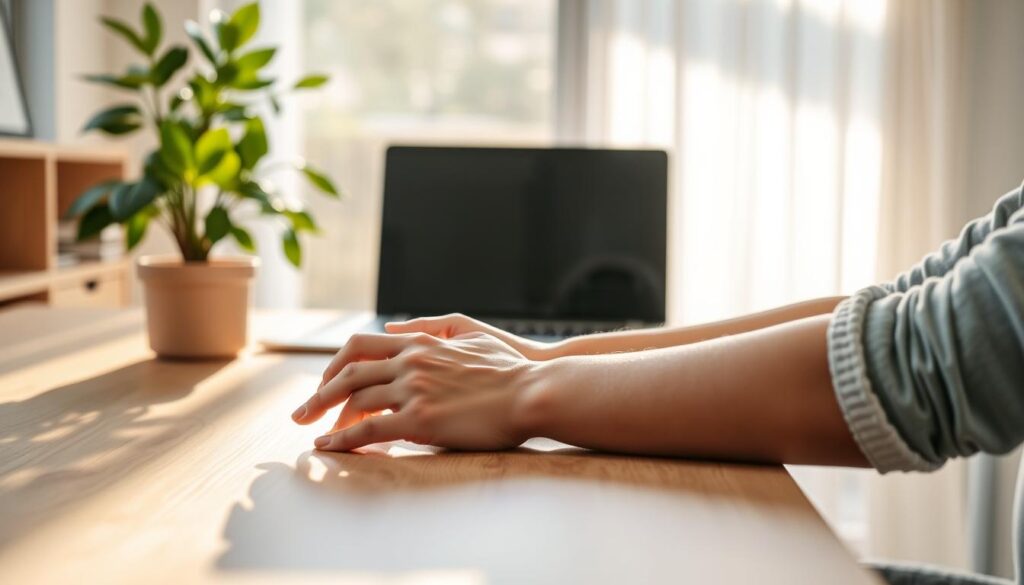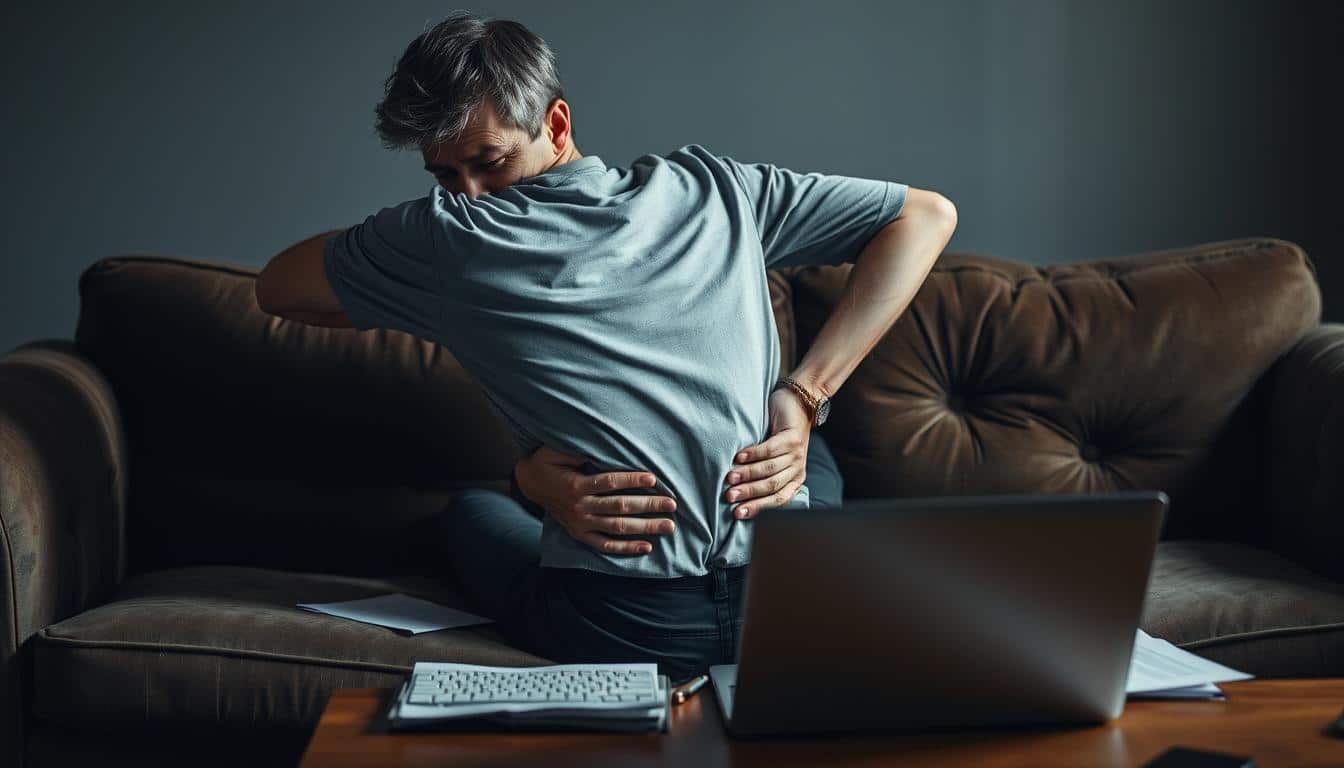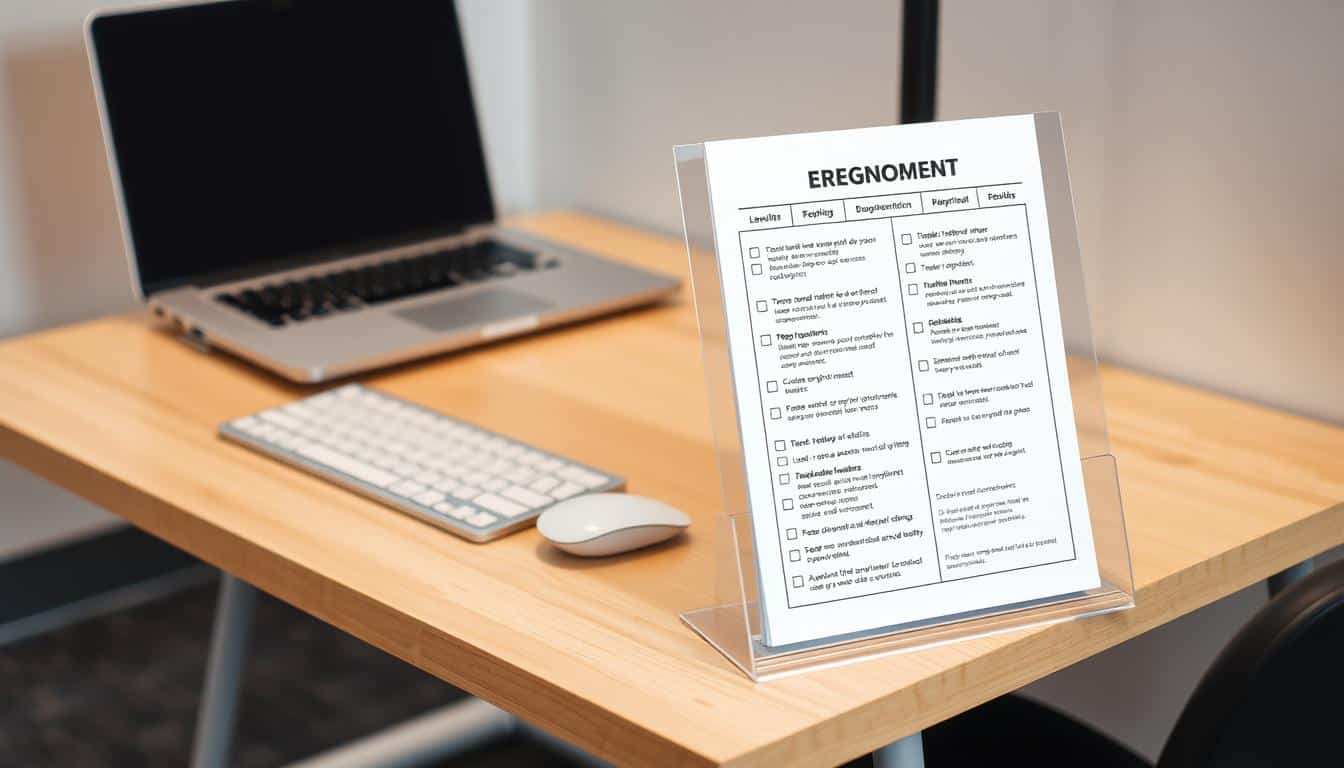The modern workplace is changing. People are looking at different ways to sit while working. This is to make sure they sit correctly and avoid pain. Experts from places like the Mayo Clinic and Cornell University share tips for this. These tips help you feel good and stay healthy, even without a regular office chair. They show you how to set up your space so you can work well and comfortably.
Understanding Ergonomics in a Non-Traditional Workspace
Ergonomics is key in making a healthy and productive space, especially away from the usual office. It aims to improve how people work in their spaces, focusing on how we set up our work areas. It’s important for those using non-traditional office chairs to adjust their spaces to fit natural body positions.
Having the right desk height and sitting correctly makes a big difference in comfort. If desks and chairs are at the right height, you’re less likely to feel pain or discomfort after working long hours. Knowing this helps prevent issues with muscles and bones, as experts like the Mayo Clinic and OSHA point out.
So, understanding ergonomics in a unique work setting leads to better comfort and health. Making sure your work area is comfortable helps you work better and stay healthy in the long run.

Common Issues from Poor Sitting Posture
Sitting wrong can cause health problems, especially if you do it a lot. People might feel pain in their backs and necks. This happens because the spine and muscles around it are under stress. The Cleveland Clinic says sitting badly can make muscles stiff. It can also reduce how easily you move and cause long-term harm.
It’s important to understand the bad effects of sitting wrong. Common problems include:
- Increased back pain due to tension on spinal structures.
- Neck pain caused by improper head and neck positioning.
- Muscle stiffness impacting overall mobility.
To avoid these issues, moving regularly is key. Changing how you sit every 20-30 minutes can ease tension. It also helps in maintaining good posture.
Benefits of Sit-Stand Workspaces
Sit-stand desks are getting popular because they are good for health. Standing more can lower the risk of heart disease and diabetes. These desks help improve both how you feel and think.
Improved Health Outcomes
Switching between sitting and standing is great for your health. Research shows it can ease back and neck pain. Standing more helps you stand straighter and boosts blood flow. This means you can feel better and have more energy.
Enhanced Productivity
Sit-stand desks also make you work better. They let you switch between sitting and standing. This change helps you stay awake and focused. So, you can do your work better in a more lively office.
Choosing the Right Alternatives for Seating
Picking the right seating options is super important for a good sitting posture. It’s not just about regular chairs anymore. There are many other choices like stools, standing desks, stability balls, and special cushions. These can help make you more comfortable and improve your posture too.
Options Beyond Traditional Chairs
Lots of people are looking for different ways to sit better at work. These new seating options are not only fun but also help you sit in a healthier way. Here’s what you might consider:
- Stools can be adjusted for the perfect height and support.
- Standing desks help you move more during the day.
- Stability balls make your core work while you sit.
Choosing Stability Balls or Cushions
Stability balls have become really popular because they’re so helpful. They keep your sitting active, make your core muscles work, and help you sit straighter. But remember, it’s important to use them right to avoid back problems. Cushions, on the other hand, are made to give extra support wherever you need it. They make sitting more comfortable, suiting everyone’s different needs.
How to Sit Ergonomically Without Office Chair
Learning how to sit right without a regular chair can make you feel better and stand straighter. It’s important to keep your spine straight and your hips and knees lined up right. Doing this helps you sit comfortably, even without a standard chair.
Maintaining a Neutral Spine
For a healthy back, your lower back should slightly curve. You can use a pillow or a rolled-up towel to keep this curve in place. This not only helps keep your spine straight but also cuts down on back pain and makes sitting better for you.
Aligning Hips and Knees
Keeping your hips and knees in the right position is important for being comfy and stable. Your hips and knees should be bent at a 90-degree angle, with your feet flat on the ground or on a stool. Experts at OSHA and Mayo Clinic say this is the best way to sit. It helps you keep a good pose and sit for a long time without feeling bad.
Utilizing Supportive Accessories
Supportive accessories are key for comfort and good posture for desk workers without standard chairs. Footrests and back support can make a big difference in how you sit.
Footrests for Stability
Footrests support the right body alignment and help in reducing lower back strain. They keep your legs in a good position, making long sitting times more comfortable. When choosing a footrest, look for these features:
- Height adjustment to suit your stature
- Textured surfaces for improved grip
- Design that allows for rocking or tilting movements
Back Support Options
For ergonomic seating, back support is crucial. It keeps your spine’s natural shape. Here are some great back support choices:
- Adjustable lumbar cushions that provide targeted support
- Rolled towels or foam supports for customized backing
- Portable back support that can be used across different settings
Incorporating Movement into Your Day
Making sure you move during your day is key to fight sitting too long. Taking regular breaks is really important. Health experts say to take a break every 20-30 minutes to stand up, stretch, or walk. Doing this helps you feel better and work better.
Importance of Regular Breaks
Taking breaks often helps your body a lot. They lower the chance of pain from sitting too much and make you more focused. When you step away from work, your muscles get a chance to relax. This makes the workplace healthier and helps you do better at your tasks.
Simple Movement Exercises
Doing easy exercises during your breaks is good for your blood flow and stops stiffness. Some good ones include:
- Calf raises to make your lower legs strong
- Shoulder stretches to ease tension
- Neck rotations to make your neck more flexible
Doing these stretches at work keeps your muscles healthy and your blood moving. This is key for staying active and productive at work.
Strategies for Effective Screen Placement
Getting your screen placement right is key for comfort and to avoid eye strain. This means adjusting the height and position of your monitor. Doing so boosts productivity and promotes better posture. Let’s look at some ways to make your screen setup work for you.
Monitor Height and Distance
The top third of your screen should be at eye level. This keeps your neck from bending awkwardly. Your monitor should be 18-24 inches away from your eyes. This helps you see clearly without straining your eyes.
Reducing Eye Strain
Making small changes to where your screen sits can cut down on eye strain. Make sure the lighting in your room doesn’t make your screen glare. You might need an anti-glare screen. And try to look away from your screen every 20 minutes for 20 seconds. Having your monitor in the right spot is crucial for staying comfortable and focused.
Maximizing Comfort in Non-Traditional Positions
To stay comfy in unusual sitting spots, moving around often is key. Changing how you sit can ease muscle tension and help you avoid feeling tired. Adding some easy stretches to your daily activities helps make you more flexible and eases muscle stiffness from sitting or standing too long.
Adjusting Body Position Regularly
Keeping comfy means knowing when to move. Try to change how you sit every 30 minutes. You can twist your hips, lean from side to side, or stand up for a bit to keep the blood flowing. Moving like this can help you stay energized and comfortable all day.
Using Stretching Techniques
Adding stretches to your routine can really improve how you feel and stand. Do easy stretches like rolling your neck, shrugging your shoulders, and bending your wrists. This can soothe the parts of your body that get sore from unusual sitting. Stretch a little every hour to keep from getting stiff, which helps you feel better and move easier.
Conclusion
In wrapping up our talk on ergonomics, it’s key to see the value in good sitting habits. This is true especially with choices like standing desks. Following ergonomic rules is more than a trend. It’s a way to better our health and well-being at work.
By using the sitting tips shared here, people can choose the best seating for them. This can boost comfort and work performance. It also lessens the dangers that come from bad posture and sitting too much.
Putting ergonomics first in our daily lives leads to a healthier work environment. Small changes for better posture are a step towards a life where we feel good and work well. This ensures our work spaces are both comfy and efficient.



